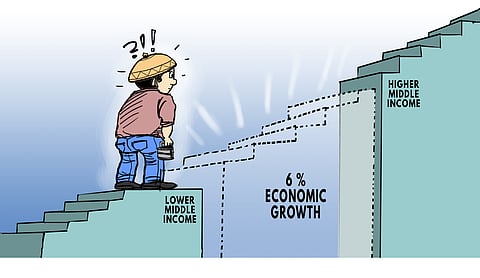
- NEWS
- the EDIT
- COMMENTARY
- BUSINESS
- LIFE
- SHOW
- ACTION
- GLOBAL GOALS
- SNAPS
- DYARYO TIRADA
- MORE

A recent statement of National Economic and Development Authority (NEDA) Secretary Arsenio Balisacan has sparked optimism among Filipinos: the Philippines’ long-awaited graduation from a lower middle-income to an upper middle-income economy might finally happen next year.
While the prospect is exciting, it however raises a serious question: is this goal truly within reach, or is it still more a dream than reality?
According to Secretary Balisacan, the Philippines could attain upper middle-income status if the economy grows by at least 6 percent this year and maintains that pace in 2026. On paper, this is achievable. The country has shown resilience, bouncing back from the economic slump of the pandemic with growth rates that many neighboring countries would envy. The challenge, however, lies not in the percentage itself but in the quality and sustainability of that growth.
Currently, the Philippines is still classified as a lower middle-income country by the World Bank.
The jump to upper middle-income status is more than just a change of label; it requires the nation to hit a specific Gross National Income (GNI) per capita threshold, which stands at about $4,466 to $13,845 based on World Bank classifications. As of today, the country’s GNI per capita remains below that minimum, although the gap is slowly narrowing.
But economic status is not just about numbers. A country’s income category should ideally reflect the quality of life of its people — and this is where the Philippines still faces considerable hurdles.
Despite respectable economic growth, the country continues to grapple with serious social and economic issues such as underemployment, a high poverty rate, food insecurity, and lagging literacy in certain regions. The growing economy has yet to translate to meaningful improvements for the average Filipino.
Balisacan was quick to point out that while growth is important, the country needs to address deeper structural problems to sustain progress. Chief among these are the issues of investment climate, infrastructure, governance, and ease of doing business. Without solving these bottlenecks, the target would remain out of reach.
For years, foreign and local investors alike have raised concerns about the difficulty of doing business in the Philippines, from complicated government permit systems to inconsistent tax policies and bureaucratic red tape. Likewise, the quality of public infrastructure — roads, ports, airports, digital connectivity — must improve if the country hopes to compete regionally and globally.
Governance also remains a critical factor. Investors seek stable, predictable, and transparent rules, but policy flip-flops, corruption issues, and political uncertainty have all historically dampened investor confidence. Reforms in public administration and continued anti-corruption efforts are necessary to maintain long-term economic growth.
Achieving upper middle-income status would bring many benefits: improved credit ratings, more investor confidence, and stronger global standing. However, if the growth is not inclusive, the economic upgrade risks becoming a hollow victory. The government must ensure that the growth translates to better paying jobs, a stronger social safety net, and more equal opportunities across sectors and regions.
In the end, the road to upper middle-income status is both an economic and a social challenge. The potential is real, but the question is whether the Philippines can muster the political will and policy focus to make that leap not just statistically, but meaningfully — so that ordinary Filipinos, not just the numbers, can feel the change.
